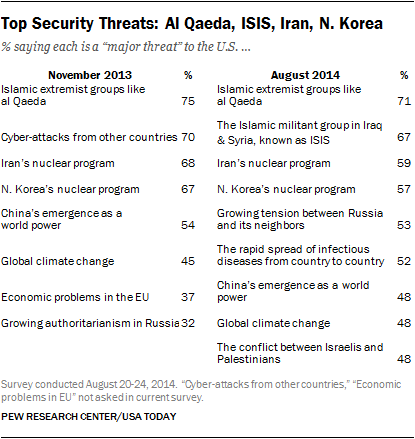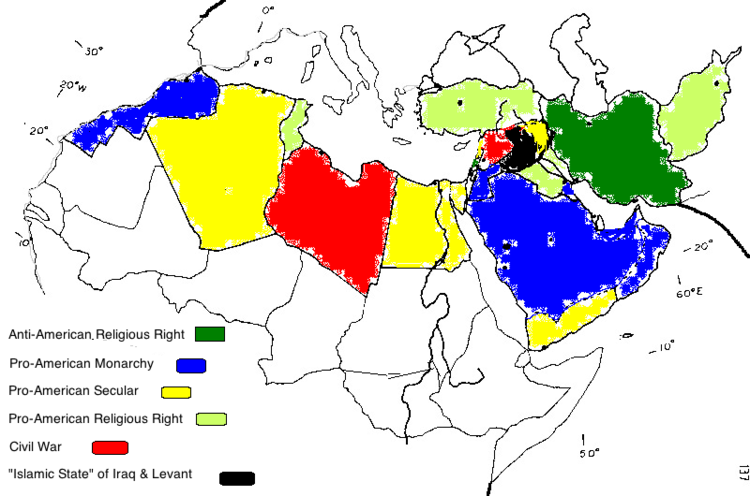Americans Are Worried about ISIS and Putin. What They Should Be worried About is Climate Change.
In a new Pew/ USA Today poll, the American public shows itself alarmed by the rise of the so-called Islamic State of Iraq and the Levant in northern Iraq and Syria as a threat to US security, finding it more threatening even than Russia’s Vladimir Putin, who has risen on the villain scale quite a lot. Iran is seen as less menacing, as is North Korea. The Israel-Palestinian struggle is seen as a threat to the US by a little over half. More Americans still think the US is doing too much as the world’s policeman, but those who think it is doing too little have greatly increased in number, especially among Republicans.
But almost no Republicans think Global Warming is a threat, and only slightly more than a majority of Democrats do. In short, the US public is again being misled by its media and politicians as to the true shape of the world, and is likely to suffer pretty badly for this ignorance.
Americans’ concern about the rise of the so-called “Islamic State” is justified. It is an extremely nasty and vicious organization, and it has made significant advances this summer in northern Iraq. The public largely supports giving US close air support to Kurdish and Iraqi military forces against it.
But it seems likely that the public is not being given a sense of proportion about the region. Conservative pro-American monarchies in the Middle East include Morocco, Jordan, and the members of the Gulf Cooperation Council. Secular republics that are non-NATO allies or at least relatively friendly toward the US include Algeria, Egypt and Yemen (though Yemen has local militant movements not under government control). Governments of the mild religious right have risen in Tunisia and Turkey but they are pro-American (Turkey is a NATO ally). Lebanon is hard to categorize– its government is pro-American but it includes Hizbullah which is not. It is not clear how much of the militia faction-fighting in Libya is a security threat to the US, and apparently people have been relatively unconcerned by the Syrian civil war until recently.
Of the some 400 million people in the Middle East, only a fraction live under IS — half of what’s left of Aleppo, the small city of Raqqa, Mosul and some other Iraqi cities. Given refugee flows (at least a fourth of Mosul fled), I shouldn’t imagine it is more than five or six million. It would be alarming if a militant group took over Tennessee or Wisconsin, but it is not as if those states bulk very large in a US of some 314 million. Given how vicious IS is, I don’t think it should be allowed to keep its conquests, and I think the international community can and should coordinate with local actors to push it back. In a way, IS is made for concerted United Nations action, since it alarms all the members of the Security Council.
But while the Ukraine conflict is concerning, it is a struggle between Russia and the European Union for a sphere of influence and therefore is largely a regional matter. It is hard to see how it poses a threat to the US or requires an intervention beyond tools such as sanctions (which have clearly had some effect in restraining Russia, though they haven’t been completely successful).
Iran is not a threat to the US. It is a country of some 75 million with a small conventional army that hasn’t invaded a neighbor for a century and a half and has a military budget between that of Norway and Singapore. It was never more than a bogeyman wielded by right wing US politicians to scare the people. The government of President Hassan Rouhani is clearly trying to reach a new modus vivendi with the US. The public is right to demote it further as a menace given the current negotiations.
North Korea is also not a threat to the US. Interestingly, China is seen by fewer Americans as a menace, presumably because Secretary of State John Kerry has good relations with Beijing and has played down the “pivot to Asia” rhetoric, some of which was aimed at preparing the way to an effort to contain China.
None of these threats is very serious for the actual lives lived by most Americans.
But Global Warming (what experts call Climate Change) is a dire threat to the health and well-being of millions of Americans. In the coming decades it will do trillions of dollars of damage to the American economy. Imagine what the city of Miami is worth; but much of it is doomed . We have locked in a four foot sea level rise over the next 80 years or so. But that is an average. In some places it will be higher (the ocean is not smooth). There will be episodes of rapid rise and storm surges leading to substantial coastal flooding for some towns and cities.
You are much more likely to die falling in the bathtub or being struck by lighting than to be killed by terrorists or by Vladimir Putin, much less by Hassan Rouhani of Iran. But Americans’ health and well-being is directly and powerfully threatened by global warming.
What to do about IS is not completely clear (President Obama has gotten into trouble for saying that he doesn’t yet have a policy for dealing with it in Syria, which actually was his way of walking back the assumption in the US press that he intends to bomb Syria unilaterally). Over time an approach will be crafted.
What to do about global warming is obvious. Stop spewing 34 billion metric tons of carbon dioxide into the atmosphere every year. CO2 is a greenhouse gas that prevents the sun’s heat from radiating back out into space from the earth’s surface. The more you have in the atmosphere, the hotter it is guaranteed to become over time. We’ve gone from 270 parts per million of carbon dioxide in the atmosphere in the 18th century before the industrial revolution to over 400 parts per million today. We crossed that 400 ppm line just this year. There should have been urgent summits and hand wringing on Capitol Hill and massive urban demonstrations.
Our press and our politicians are screwing us over. We still take our cues from our two parties and from corporate mass media. Both are in effect lying to us on the whole, by not being shrill over the real problems we face. American political leaders and American television anchors are encouraging us to hold a dance party on the deck of the Titanic.
The last time carbon dioxide levels spiked the way we are making them spike today, in the Eocene epoch 50 million years ago, it wasn’t a pretty picture. Carbon dioxide goes into the oceans, making them acidic and killing off much sea life. Lots of humans live on fish; there won’t be any for many of them. It was tropical everywhere, with no surface ice. There was a third less land mass above the waters. There is some evidence of massive storms, some lasting thousands of years over the same area. Past eras like the Eocene reinforce the conclusions reached by climate modelers. Modeling can err, if the inputs are mistaken. But History does not lie. C02 levels matter for the health of the earth. We have a young species, only about 150,000 years old, and it is adapted to a relatively cool world. Can it survive another Paleocene-Eocene Climate Maximum?
We are locked in to going up by 4 degrees F. (scientists in the US should stop using Centigrade, which seems to downplay the problem to an American audience). There is no escaping it. But whether we go on up to a 9 degrees F. average rise in surface temperatures is up to us. To this generation. We could go to solar and wind as energy sources in a crash Manhattan Project-style effort over the next 20 years. We’d actually save money in the long run if we do it, not to mention averting some of the worst effects of global warming (loss of coasts, droughts, wild fires, species lost, extreme weather). We’d also free ourselves and our allies of dependence on foreign oil and gas. If you own a house and will be in it at least ten years, you’re crazy if you don’t put up solar panels and get an electric car or plug-in hybrid. At current prices you’d pay off both in 6 or 7 years and ever after you get free fuel. I did this and figure my household has avoided 3 metric tons of C02 so far this year. More extensive measures are needed that only governments (municipal, county, state and federal) can implement. But American homeowners can make an impact all by themselves. You get a $7500 tax break on the panels and another one on the auto. Every American produces on average 16 metric tons of carbon dioxide every year, more per capita than any other major industrialized country in the world. We have met the terrorists, and they are us.

